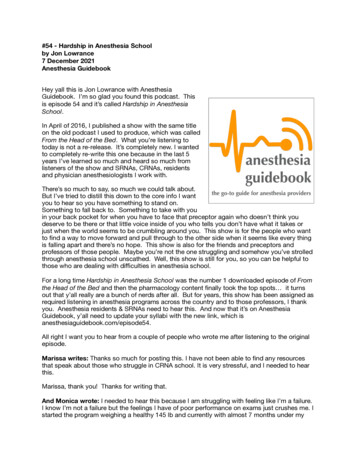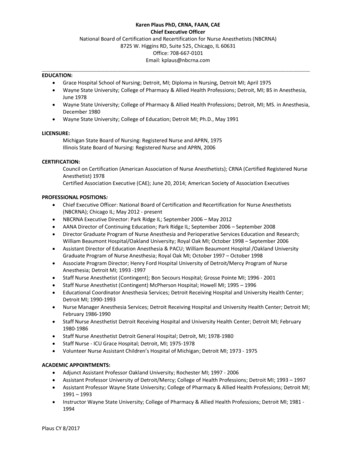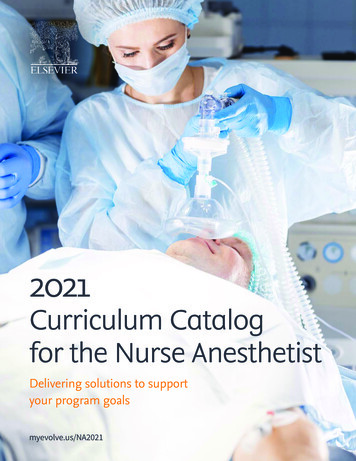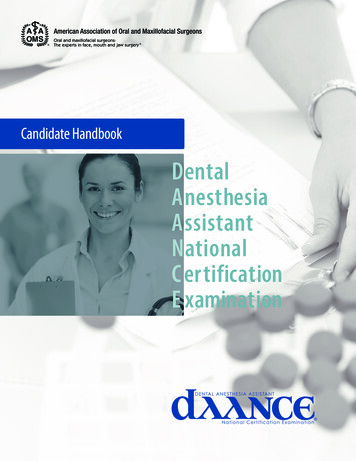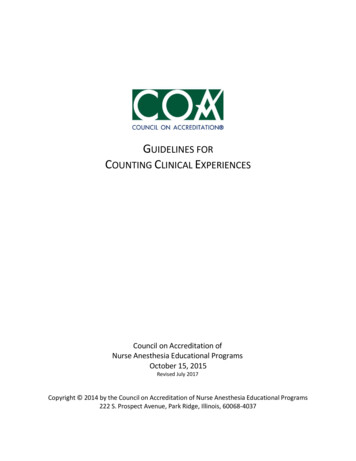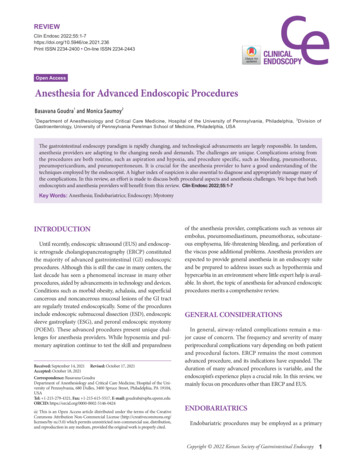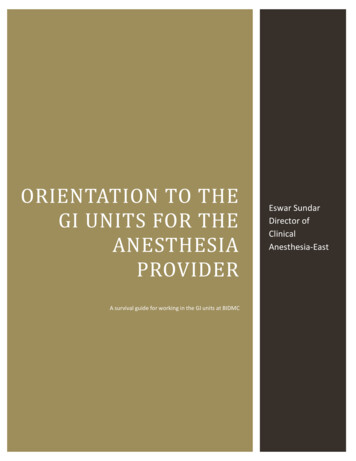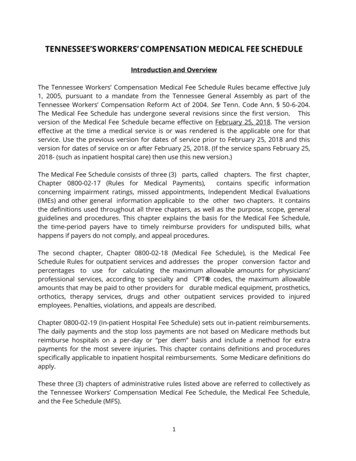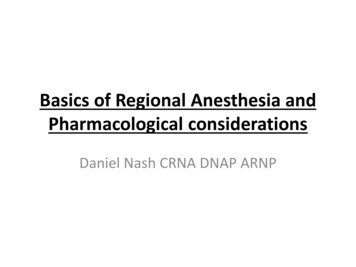
Transcription
Basics of Regional Anesthesia andPharmacological considerationsDaniel Nash CRNA DNAP ARNP
ObjectivesAfter this presentation the learner will Recognize reasons for using nerve blocks Understand the differences, advantages and disadvantages ofthe 2 main nerve block techniques Have an understanding of local anesthetic pharmacology Have knowledge of the protocol for treating Local AnestheticSystemic Toxicity (LAST) Be able to choose patient and goal specific block/drugcombinations Compare the Femoral and Adductor Canal blocks foradvantages and disadvantages
Why?
Why regional? PONV Urinaryretention nSatisfactionIncreasedrevenue
TechniquePractical& SafeClinicallyEffectiveTECHNIQUE?Easy toLearnCostEffective
Nerve Stimulation
mA Intensity to proximity
Nerve meConsistent Landmarks
DisadvantagesNerve onshipVariant Anatomy1 injection
Ultrasound
nRepositioningAnesthetic SpreadVisualizationLower Volumes
ostNew SkillDevelopmentTime
Combined TechniquesNerveStimulationUltrasoundDualAdvantage
Local AnestheticsPatient and Goal specific
Classes of Local AnestheticsEsters & Amides: Differences? Metabolism Amides: Hepatic Esters: Plasma Cholinesterases Potential for Allergic Reactions: Esters AmidesVery Rare: Almost always due to the Preservative (ParaAminobenzoic Acid)
Local anesthetics Block sodium gatedchannelsOnset- pKa (ionized vs non-ionized) Closer to physiopH, more non-ionized, faster onset. Exceptions Chlorprocaine &Benzocaine? Possible intrinsic chemical propertiesPotency- lipid solubilityDuration- protein binding and lipid solubilityAdjuvants like epi,decadron,bicarb,clonidine- acidosis can decreases protein binding by a factor of 6 and can lead totoxicity. (Nysora 10/14/2013 16:40:00 )
Local Anesthetic Systemic ascarToxicityDependent onrate & extentof absorptionTotalDoseAddition ofEpinephrine
Absorption Rate of LA’s Highest Lowest Intercostals Caudal Epidural Brachial Plexus Sciatic Lumbar Plexus Femoral
Signs of CNS ToxicityExcitatory!!!Circumoral numbnessVisual disturbance“train in my head”
Signs of Cardiovascular Toxicity Initially HR and BP With higher levels of LA’s Hypotension Arrhythmias Cardiac Arrest
LipidRescue TREATMENT FOR LOCAL ANESTHETIC-INDUCED CARDIAC ARREST PLEASEKEEP THIS PROTOCOL ATTACHED TO THE INTRALIPID BAG In the event of local anesthetic-induced cardiac arrest that is unresponsive to standardtherapy, in addition to standard cardio-pulmonary resuscitation, Intralipid 20% should begiven i.v. in the following dose regime: – Intralipid 20% 1.5 mL/kg over 1 minute – Followimmediately with an infusion at a rate of 0.25 mL/kg/min, – Continue chest compressions (lipid must circulate) – Repeat bolus every 3-5 minutes upto 3 mL/kg total dose until circulation is restored – Continue infusion until hemodynamicstability is restored. Increase the rate to 0.5 mL/kg/min if BP declines– A maximum total dose of 8 mL/kg is recommendedIn practice, in resuscitating an adult weighing 70kg:– Take a 500ml bag of Intralipid 20% and a 50ml syringe. – Draw up 50ml and give stati.v., X2 – Then attach the Intralipid bag to an iv administration set (macrodrip) and run it.i.v over the next 15 minutes – Repeat the initial bolus up to twice more – if spontaneouscirculation has not returned.If you use Intralipid to treat a case of local anaesthetic toxicity, please report it atwww.lipidrescue.org. Remember to restock the lipid.Ver 7/06
Patient and Goal specific dosing What is procedure? Single shot or catheter Age considerations Disease processes Post op rehab: ambulation Surgeon preferences
Common blocks Brachial Plexus- ISB, SCB, AxillaryFemoralFICBAdductor CanalSciaticIPACKTAP (transversis abdominus plane)
Femoral vs Adductor Canal
Femoral Nerve Block2 branches Anterior Posterior saphenous
Historical Standard Block ACL reconstruction Total Knee Arthroplasty ORIF Ankle with Sciatic Patellar femoral reconstruction Does not reliably cover Tibial Plateau fxs alone- needsciatic block also
Landmarks for PNS
Ultrasound View
Advantages Very dense block- great pain relief Easy to perform with either technique High % of success Covers tourniquet pain Can use PNS technique- if US not available
Disadvantages Quadriceps weakness Slower time to ambulate Longer length of stay in hosp. Danger of falling Patients feel unsafe walking
Local Anesthetic Choice Typically 30ml of 0.5% Bupivacaine or Ropivacainefor single shot blocks Can use continuous infusion via a catheterat 4-8ml/hr
Adductor Canal Block Relatively new block- first described in 1993by van der Mal1 In 2009, Horn and colleagues described usingUS to approach blocking the saphenous nerveusing its close anatomical association to thedescending genicular artery2 2011, Lund et al describe block for analgesiafor major knee surgery3
Adductor Canal block Developed to help preserve quadricepsstrength and provide adequate analgesicfollowing major knee surgery TKR or any arthroscopic knee procedure (ACL) 2013 double blind RCT by Jaeger et al4, and2014 RCT by Kim et al5, showed preservationof quad strength and comparable pain reliefcompared to femoral nerve block.
Local Anesthetic Choice Typically 30ml of 0.5% Bupivacaine or Ropivacainefor single shot blocks Can use continuous infusion via a catheterat 4-8ml/hr Catheter may need to placed post-operativelyto avoid the sterile field
Conclusion Choose proper technique– Dual usage offers advantages Dose drug specifically for patient & goalFemoral is standard bearer, long, safe historyAdductor Canal maintains Quad strengthwww.maverickanesthesia.com Learn fromsome of the best in the business.
Remember!!WWW.LIPIDRESCUE.ORG
References1. van der Wal M, Lang SA, Yip RW.Transsartorial approach for saphenous nerve block. Can JAnaesth 1993;40(6):542-5462. Horn J, Pitsch T, Salinas F, et al. Anatomic basis to theultrasound-guided approach for saphenous nerve blockade. RegAnesth Pain Med. 2009;34(5):486-489.3. Lund J, Jenstrup T, Jaeger P, et al. Continuous adductorcanalblockade for adjuvant post-operative analgesia aftermajor knee surgery: preliminary results. Acta AnaesthesiolScand. 2011;55:14–19.
References4. Jaeger et al, Adductor Canal Block Versus Femoral NerveBlock for Analgesia After Total Knee Arthroplasty. Reg AnesthPain Med. 2013;38(6)526-5325. Kim et al, Adductor Canal Block versus Femoral Nerve Blockfor Total Knee Arthroplasty. Anesthesiology 2014;120:520-50
Basics of Regional Anesthesia and Pharmacological considerations Daniel Nash CRNA DNAP ARNP. Objectives After this presentation the learner will Recognize reasons for using nerve blocks Understand the differences, advantages and disadvantages of the 2 main nerve block techniques

